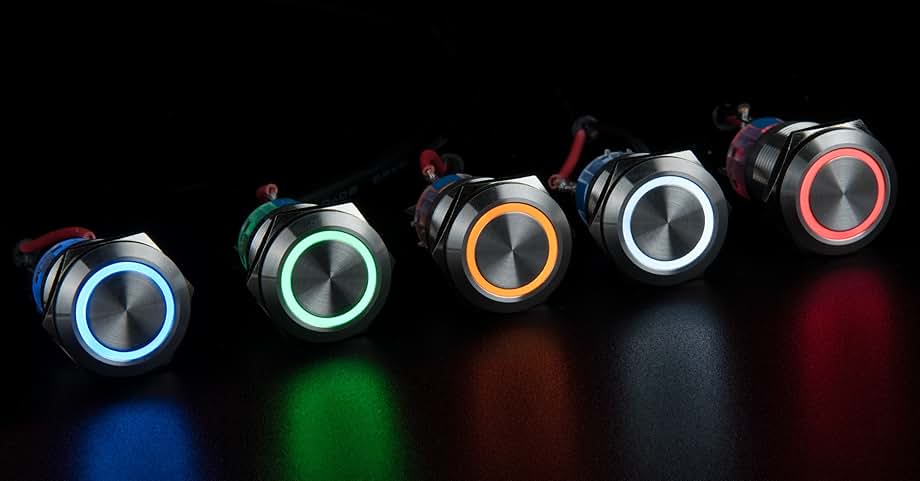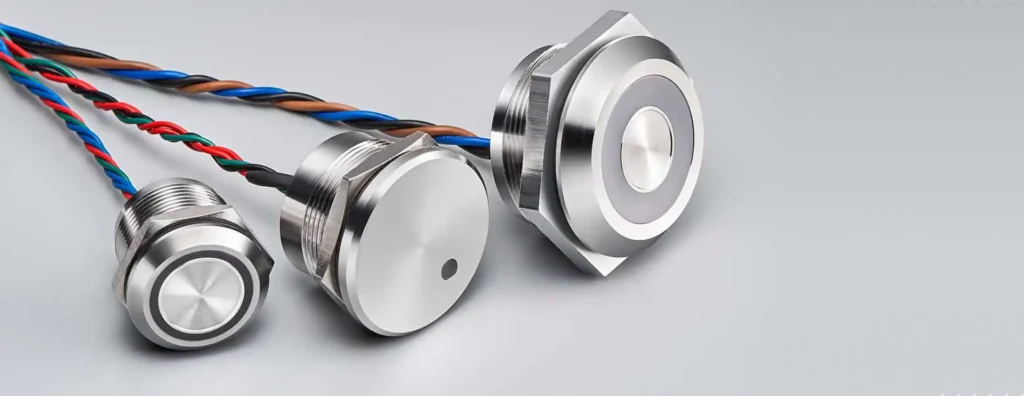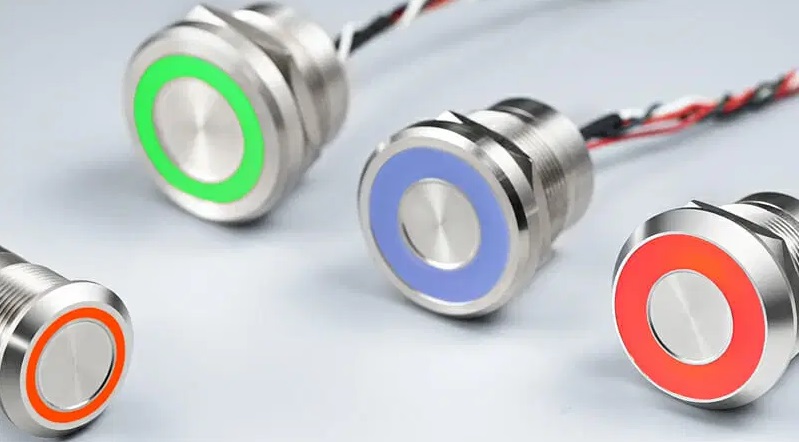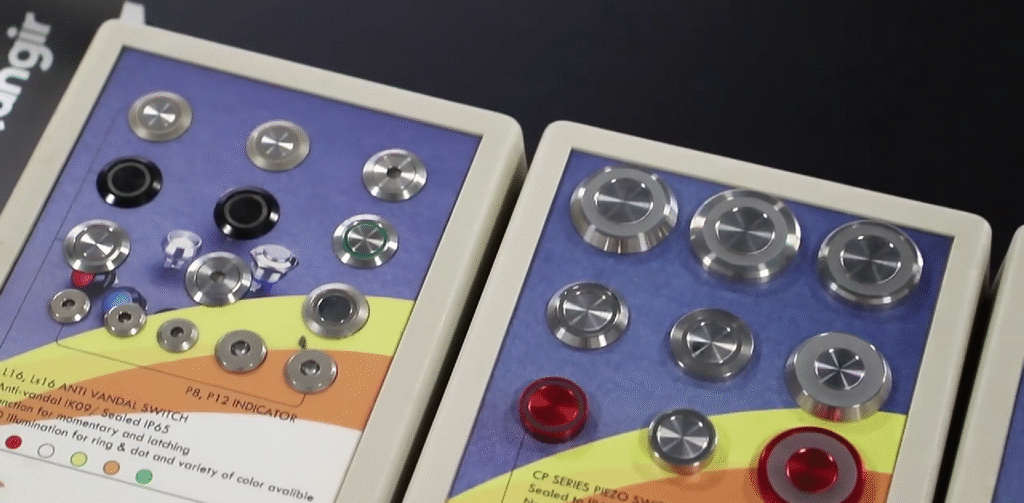Möchten Sie ein Kabel an einem kapazitiven Sensormodul TTP223 anbringen, um dessen Berührungserfassungsbereich zu vergrößern? Die Vergrößerung der Berührungsfläche mit einer externen Leitung erhöht die Nutzbarkeit in industriellen Bedienfeldern, Geräteschnittstellen oder kundenspezifischen Steuerungssystemen erheblich. Dieser Leitfaden führt Sie durch die Funktionsprinzipien des TTP223-Sensors, praktische Methoden für das Hinzufügen von Leitungen, die Auswahl geeigneter Materialien, Empfindlichkeitsanpassungen und reale Anwendungen - alles auf der Grundlage von Langirs Erfahrung in der Massenproduktion und bei kundenspezifischen Lösungen.
Sie erhalten Einblicke in:
- Die grundlegende Funktionsweise und die inhärenten Grenzen des TTP223-Touchsensors.
- Effektive Techniken für das Löten von Anschlüssen und das Entwerfen benutzerdefinierter PCB-Pads.
- Geeignete dielektrische und leitfähige Materialien für Overlay-Anwendungen.
- Feinabstimmung der Empfindlichkeit durch Integration von Kondensatoren, Erdungsstrategien und Abschirmung.
- Vergleich der Vorteile von industriellen kapazitiven Schaltern gegenüber herkömmlichen mechanischen Tasten.
- Langirs umfassende Anpassungsdienste, der Prozess der Angebotserstellung und die strenge Qualitätssicherung.
Sehen wir uns an, wie ein einfacher Draht einen normalen kapazitiven Schalter in ein robustes Steuerelement mit erweitertem Bereich verwandeln kann.
Anwendungen von kapazitiven Touchsensoren
Kapazitive Berührungssensoren sind aus der modernen Elektronik nicht mehr wegzudenken. Sie ermöglichen die Interaktion in Smartphones, hochentwickelten Bedienfeldern und intuitiven Eingabegeräten durch Berührungs- und Gestenerkennung. Ihr Nutzen erstreckt sich auch auf anspruchsvolle Industrie- und Automobilbereiche.
DigiKey TechForum, Berührungssensoren: Typen, Anwendungen und Auswahltipps (2024)
Diese Referenz unterstreicht die weite Verbreitung von kapazitiven Berührungssensoren und bietet einen wesentlichen Kontext für das Verständnis des Wertes einer Erweiterung ihres Berührungsbereichs für spezielle Anwendungen.
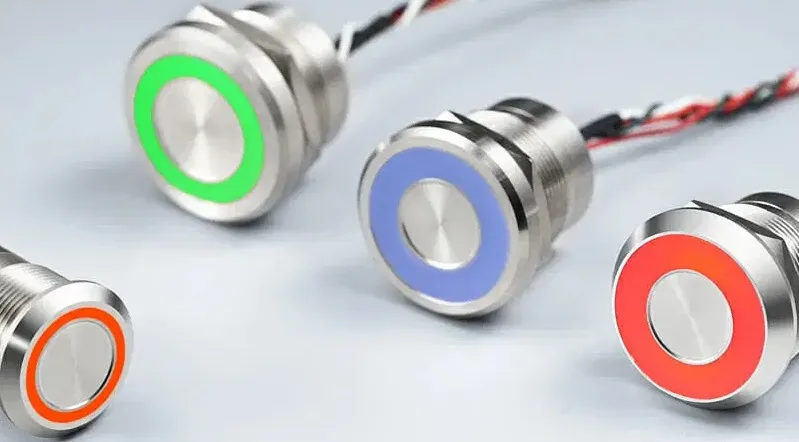
Ein Angebot für kundenspezifische kapazitive Schalter von Langir anfordern
Wie funktioniert der kapazitive Touchsensor TTP223?
Der TTP223 ist ein spezieller integrierter Schaltkreis, der für die Erkennung von Berührungen mit einer Taste entwickelt wurde. Er funktioniert, indem er winzige Änderungen der Kapazität erfasst und ein digitales Signal ausgibt, wenn die menschliche Berührung sein elektrostatisches Feld verändert. Durch die präzise Interpretation feiner Verschiebungen in der Ladungsverteilung auf seiner internen Elektrode erzeugt er ein stabiles hohes oder niedriges Ausgangssignal und ist damit ein idealer Ersatz für mechanische Drucktasten in Umgebungen, die eine robuste Abdichtung oder Beständigkeit gegen raue Bedingungen erfordern. Das Verständnis dieses Kernmechanismus ist der Schlüssel zur effektiven Erweiterung seiner Sensorfähigkeiten durch externe Komponenten.
TTP223 Kapazitiver Tastsensor Übersicht
Der TTP223 ist ein Touchpad-Detektor-IC, der entwickelt wurde, um die Funktion einer einzelnen taktilen Taste zu emulieren und eine moderne Alternative zu herkömmlichen Direktkontakttasten zu bieten. Er verfügt über einen integrierten berührungsempfindlichen Bereich und bietet konfigurierbare Optionen für Ausgabemodi und Empfindlichkeitseinstellungen.
Makers Electronics, TTP223 Kapazitiver Berührungssensor (n.d.)
Diese Quelle bietet ein grundlegendes Verständnis des TTP223-Moduls und seiner Kernfunktionen und dient als wichtige Referenz für diesen Artikel.
Was sind die wesentlichen Bestandteile des TTP223-Moduls?
Die typische TTP223-Breakout-Platine besteht aus mehreren Schlüsselelementen:
Diese Komponenten arbeiten zusammen, um eine stabile Basiskapazität aufrechtzuerhalten und durch Berührung hervorgerufene Schwankungen zu erkennen, und ebnen so den Weg für die Integration externer Elektroden, die als sekundäre Sensorflächen fungieren.
Wie ermöglicht die Kapazitätserfassung die Berührungserkennung?
Die kapazitive Abtastung beruht auf der Fähigkeit des Moduls, geringfügige Veränderungen in einem von seiner Elektrode erzeugten elektrischen Feld zu messen. Wenn sich ein Finger dem Sensor nähert:
- Umverteilung der Ladung: Die Anwesenheit des menschlichen Körpers führt zu einer kleinen Kapazität parallel zur Sensorelektrode.
- Schwellenüberschreitung: Der integrierte Schaltkreis vergleicht diesen geänderten Ladungspegel mit einer vordefinierten Basiskapazität.
- Signalerzeugung: Bei Überschreiten des Schwellenwerts wird ein digitales Ausgangssignal umgeschaltet, das eine gültige Berührungsinteraktion bestätigt.
Diese schnellen Vorgänge im Mikrosekundenbereich gewährleisten eine zuverlässige, berührungslose Interaktion und bieten im Vergleich zu herkömmlichen mechanischen Schaltern eine bessere Haltbarkeit und Abdichtung. Wenn der Erfassungsbereich mit externen Elektroden oder Drähten erweitert wird, ändert sich das Grundlinienfeld, was eine sorgfältige Konstruktion und Kalibrierung erfordert, um eine konsistente und wiederholbare Erfassungsleistung zu gewährleisten.
Was sind die Einschränkungen des Standard-Tastbereichs des TTP223?
Die Erfassungsmöglichkeiten des TTP223 sind durch die physischen Abmessungen des integrierten Kupferpads und die internen Standardeinstellungen des ICs eingeschränkt:
- Elektrode Abmessungen: Die Erfassungsfläche beträgt in der Regel weniger als 10 mm², was die effektive Reichweite einschränkt.
- Erfassungsbereich: Der Sensor kann Berührungen durch Overlay-Materialien von 1 bis 3 mm Dicke hindurch effektiv erkennen, je nach den dielektrischen Eigenschaften des Materials.
- Umgebungslärm: Ungeschirmte Sensorpads sind anfällig für elektromagnetische Störungen (EMI) und statische Entladungen, was zu Fehlauslösungen führen kann.
Das Verständnis dieser Einschränkungen ist entscheidend für die Entwicklung von externen Leitungen und Overlays, die eine optimale Empfindlichkeit gewährleisten und unbeabsichtigte Aktivierungen bei der Erweiterung der Touch-Oberfläche verhindern.
Wie kann ich den Berührungsbereich eines kapazitiven Schalters TTP223 vergrößern?
Um den Berührungsbereich des TTP223 zu erweitern, müssen Sie eine externe Elektrode - entweder ein Kabel oder ein kundenspezifisches PCB-Pad - erstellen, die direkt mit dem Sensoreingang verbunden ist. Auf diese Weise wird die interaktive Oberfläche effektiv vergrößert, während die Kernlogik des Moduls erhalten bleibt. Dies ermöglicht die Touch-Aktivierung durch dickere Panels oder größere Tastenbereiche, was besonders für industrielle Anwendungen von Vorteil ist.
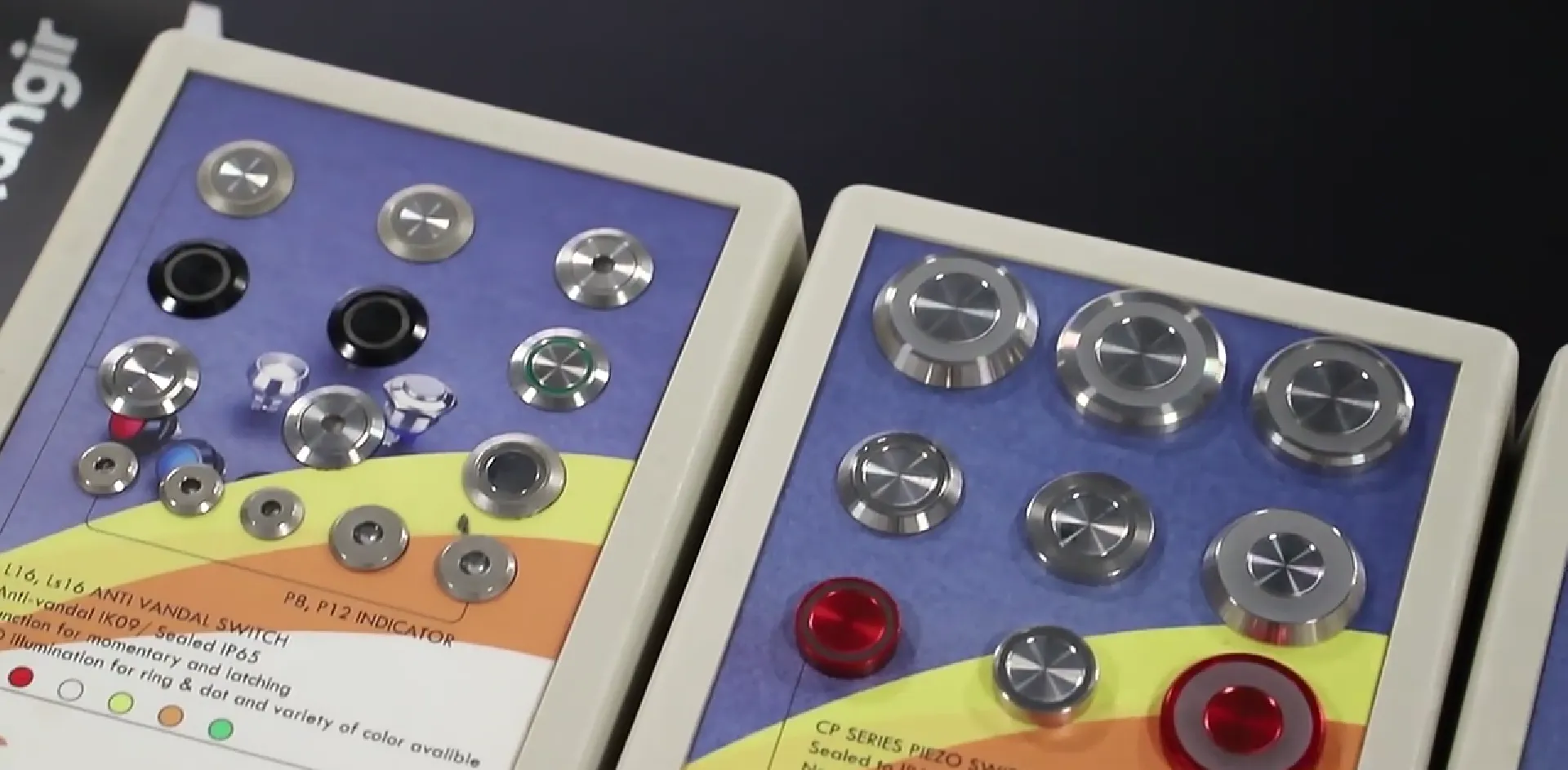
Ein Angebot für kundenspezifische kapazitive Schalter von Langir anfordern
Ist es möglich, eine externe Leitung oder ein Kabel an den TTP223-Sensoreingang anzuschließen?
Unbedingt. Sie können einen leitfähigen Draht oder ein Flachbandkabel direkt an den Testpunkt der Berührungselektrode oder an das dafür vorgesehene Pad des Moduls löten. Befolgen Sie diese empfohlenen Schritte:
- Tragen Sie eine dünne Schicht Lötzinn sowohl auf das Elektrodenpad als auch auf die Drahtspitze auf.
- Bringen Sie mit einem Lötkolben mit feiner Spitze vorsichtig einen isolierten Kupferdraht (22-28 AWG) an.
- Befestigen Sie das Kabel an der Unterseite des Moduls, um es zu entlasten und Beschädigungen zu vermeiden.
- Versiegeln Sie die Lötverbindung mit Epoxid oder Heißkleber, um die Vibrationsfestigkeit zu erhöhen.
Erweiterung der Touchbereich-Funktionen
Zur Vergrößerung des Berührungsbereichs eines TTP223 wird ein leitfähiger Draht angelötet oder ein kundenspezifisches PCB-Pad hergestellt, das mit dem Sensoreingang verbunden ist, wodurch die interaktive Oberfläche vergrößert wird. Diese Technik erleichtert die Touch-Aktivierung durch dickere Panels oder größere Tastendesigns.
AskElectronics, Gibt es eine Möglichkeit, den Erfassungsbereich dieser kapazitiven Berührungssensoren zu vergrößern, wenn er zu klein ist? (2023)
Diese Quelle bestätigt die Durchführbarkeit der Erweiterung von Berührungsbereichen mit leitfähigen Materialien, ein zentrales Thema dieses Artikels.
Indem Sie die Elektrode auf diese Weise verlängern, schaffen Sie eine Fernabtastfläche, die ähnlich wie das ursprüngliche Pad funktioniert. Diese Änderung erfordert jedoch eine Empfindlichkeitsabstimmung, um die zusätzliche Kapazität zu kompensieren.
Was sind die besten Praktiken für das Design von externen Elektroden und PCB-Touchpads?
Bei der Entwicklung kundenspezifischer PCB-Pads oder Overlay-Elektroden sollten Sie diese Designprinzipien berücksichtigen:
- Form des Pads: Entscheiden Sie sich für runde oder ovale Kanten, um eine gleichmäßigere Verteilung des elektrischen Feldes zu gewährleisten.
- Kupferdicke: Verwenden Sie 1 oz Kupfer oder dicker für verbesserte Signalstabilität.
- Breite der Spur: Halten Sie eine minimale Leiterbahnbreite von 0,5 mm von jedem Massepunkt ein, um kapazitive Leckagen zu minimieren.
- Freiräume: Verwenden Sie einen Schutzring, der mit der Erde verbunden ist und das Pad umgibt, um das elektrische Feld effektiv zu bündeln.
Die Einhaltung dieser Layout-Richtlinien stellt sicher, dass Ihre externe Elektrode eine konsistente Kapazitätsänderung bietet, ohne dass es zu einer unbeabsichtigten Signalkopplung mit angrenzenden Schaltungen kommt.
Wie wirken sich Leitungslänge und Abschirmung auf die Berührungsempfindlichkeit und -stabilität aus?
Größere Leitungslängen können zu parasitären Kapazitäten führen und als Antennen wirken, was die Anfälligkeit für Störungen erhöht. In der Praxis bedeutet dies:
Kurze, nicht abgeschirmte Kabel sorgen in der Regel für ein reaktionsschnelles Tastgefühl. Bei längeren Strecken ist die Verwendung von koaxialen oder foliengeschirmten Kabeln und die Nachjustierung des Empfindlichkeitsreglers mit einem kleinen Kondensator für einen stabilen Betrieb jedoch unerlässlich.
Welche Materialien eignen sich für die Erweiterung der kapazitiven Touch-Oberfläche?
Die Auswahl geeigneter Overlay- und Elektrodenmaterialien ist entscheidend für die zuverlässige Leistung Ihres erweiterten Berührungsschalters, insbesondere beim Betrieb durch Abdeckplatten oder Gehäuse hindurch.

Ein Angebot für kundenspezifische kapazitive Schalter von Langir anfordern
Welche dielektrischen Materialien unterstützen Touch Throughlays effektiv?
Die Wahl des Trägermaterials beeinflusst die Reichweite und die taktile Rückmeldung erheblich:
Diese Materialien bieten ein ausgewogenes Verhältnis zwischen Sensibilität und Schutzeigenschaften und ermöglichen die Aktivierung von Berührungen durch robuste und leicht zu reinigende Oberflächen.
Wie wirkt sich die Dicke des Overlays auf die Leistung der kapazitiven Sensorik aus?
Mit zunehmender Dicke des Overlay-Materials ist eine größere Kapazitätsänderung zur Erkennung erforderlich:
- Bis zu 1 mm: In der Regel ist eine minimale Anpassung der Empfindlichkeit erforderlich.
- 1-3 mm: Es wird oft empfohlen, einen Abstimmkondensator von 10-20 pF hinzuzufügen.
- Über 3 mm: Es wird empfohlen, mehrere dielektrische Schichten gründlich zu testen und eine mechanische Auslösesicherung in Betracht zu ziehen.
Die Wahl von Overlay-Materialien unter 3 mm gewährleistet in der Regel eine zuverlässige Leistung, ohne dass eine übermäßige Empfindlichkeitseinstellung erforderlich ist.
Effiziente Abstimmung von kapazitiven Messsystemen
Die maximale Empfindlichkeit eines kapazitiven Sensors wird durch die physischen Abmessungen des Sensors selbst in Kombination mit der Dicke und der Dielektrizitätskonstante des Überzugsmaterials bestimmt. Eine ordnungsgemäße Kalibrierung ist eine grundlegende Voraussetzung für jedes kapazitive Sensordesign, um falsche Aktivierungen und Sensorfehlfunktionen zu vermeiden.
DigiKey Australia, Effiziente Abstimmung von kapazitiven Sensorentwürfen (2011)
Diese Quelle liefert wertvolle Hinweise zur Sensorabstimmung, die bei der Änderung des Berührungsbereichs des TTP223 unerlässlich ist.
Welche leitfähigen Materialien werden für externe Ableitungen und Elektroden empfohlen?
Hier finden Sie einen kurzen Leitfaden zu geeigneten leitfähigen Materialien:
Wie kann ich die Empfindlichkeit des TTP223 für längere Berührungsabstände einstellen?
Wenn Sie die Elektrodenfläche vergrößern oder externe Leitungen hinzufügen, verschiebt sich die Erkennungsschwelle des Sensors natürlich. Um dies zu kompensieren, müssen externe Kondensatoren hinzugefügt und geeignete Erdungstechniken implementiert werden, um eine präzise Berührungserkennung wiederherzustellen.

Ein Angebot für kundenspezifische kapazitive Schalter von Langir anfordern
Empfindlichkeit und Gestaltungsspielraum bei kapazitiven Touch-Anwendungen
Die Empfindlichkeit bei kapazitiven Touch-Anwendungen ist ein konfigurierbarer Parameter, der bestimmt, wie gut das System auf Berührungseingaben reagiert. Der Abstimmungsprozess umfasst die Festlegung eines optimalen Erkennungsschwellenwerts, der einen angemessenen Gestaltungsspielraum in Bezug auf die Signalstärke und den Umgebungsgeräuschpegel bietet.
Texas Instruments, Empfindlichkeit, SNR und Gestaltungsspielraum bei kapazitiven Touch-Anwendungen (2019)
Diese Ressource erklärt die kritische Rolle der Empfindlichkeit und deren Einstellung, die bei der Erweiterung des Tastbereichs des TTP223 von größter Bedeutung ist.
Wie lässt sich die Sensorempfindlichkeit durch Hinzufügen externer Kondensatoren anpassen?
Durch den Einbau eines kleinen Kondensators zwischen dem Empfindlichkeitsanpassungspad und Masse wird der Schwellenwert für die Ladungserkennung effektiv verändert:
- 10 pF: Erhöht die Berührungsschwelle geringfügig, geeignet für kleinere Pads.
- 22 pF: Im Allgemeinen geeignet für mittelgroße Elektroden, die mit bis zu 2 mm dicken Auflagen verwendet werden.
- 47 pF: Empfohlen für größere Elektroden oder Fernleitungen mit einer Länge von mehr als 100 mm.
Das Experimentieren mit diesen Werten ist der Schlüssel, um die optimale Einstellung zu finden, die eine zuverlässige Registrierung echter Berührungen gewährleistet, ohne dass es zu Fehlalarmen kommt.
Welche Erdungs- und Abschirmungstechniken verbessern die Störfestigkeit?
Setzen Sie die folgenden Strategien zur Verbesserung der Stabilität um:
- Integrieren Sie einen Masse- oder Schutzring um die berührungsempfindliche Leiterbahn.
- Verwenden Sie schraffierte Erdungsflächen unterhalb des Moduls, um die Impedanz zu verwalten.
- Führen Sie hochfrequente oder verrauschte Signalleitungen vom Messleiter weg.
Eine effektive Erdung kanalisiert elektromagnetische Interferenzen (EMI) effektiv vom Sensor weg und gewährleistet so eine gleichbleibende Leistung in anspruchsvollen industriellen Umgebungen.
Wie kann ich Probleme mit der Empfindlichkeit und falschen Auslösern beheben?
Wenn die Berührungsreaktion unregelmäßig oder unzuverlässig wird:
- Untersuchen Sie Lötstellen und Dichtungsmassen gründlich auf Anzeichen von eindringender Feuchtigkeit.
- Überprüfen Sie die Konsistenz der Überlagerungsdicke und die dielektrischen Eigenschaften des Materials.
- Stellen Sie den Abstimmkondensator in kleinen Schritten ein, typischerweise ±10 pF.
- Ziehen Sie in Erwägung, lange Leitungen zu kürzen oder abzuschirmen, um Antenneneffekte zu vermindern.
Ein systematischer Ansatz zum Testen jeder dieser Variablen hilft schnell, die Ursache für inkonsistente Ausgangssignale zu finden.
Was sind die industriellen Anwendungen und Vorteile der erweiterten kapazitiven TTP223-Schalter?
Erweiterte kapazitive Schalter bieten erhebliche Vorteile in Umgebungen, in denen mechanische Tasten verschleißanfällig sind oder Verunreinigungen in empfindliche Geräte eindringen können.

Ein Angebot für kundenspezifische kapazitive Schalter von Langir anfordern
Wie lassen sich erweiterte kapazitive Schalter mit mechanischen Drucktasten vergleichen?
Was sind die besten Praktiken für die Integration von TTP223 in industrielle Schalttafeln?
Um eine sichere und zuverlässige Installation zu gewährleisten, sollten Sie sich an diese Richtlinien halten:
- Erfüllen Sie die einschlägigen EMV-Normen (z. B. IEC 60947).
- Installieren Sie die Module hinter entsprechend bemessenen Gehäuseausschnitten.
- Beschriften Sie die Berührungszonen auf der Frontplatte deutlich.
- Validierung der Leistung unter verschiedenen Temperatur- und Feuchtigkeitsbedingungen.
Die Einhaltung dieser Protokolle stellt sicher, dass die erweiterten kapazitiven Steuerungen die strengen Normen erfüllen, die in der Industrie gefordert werden.
Wie hat Langir die kapazitiven Schalter für Industriekunden angepasst?
Langir hat bereits erfolgreich maßgeschneiderte Lösungen geliefert, darunter:
- Vollständig versiegelte kapazitive Tastaturen, die für die Umgebung von Lebensmittelverarbeitungsmaschinen entwickelt wurden.
- Großformatige Berührungstasten, die in Steuerkonsolen für schwere Geräte integriert sind.
- Multi-Pad-Sicherheitsverriegelungssysteme mit kundenspezifisch gestalteten Overlays.
Unsere Kunden profitieren von wettbewerbsfähigen Großmengenpreisen, beschleunigten Prototyping-Zyklen und einer sorgfältigen Qualitätskontrolle, die auf die Anforderungen kritischer Anwendungen zugeschnitten ist.
Wie kann ich kundenspezifische kapazitive Schalterlösungen mit Leitungsverlängerungen von Langir erhalten?
Langir zeichnet sich durch hohe Stückzahlen und kundenspezifische Designs aus, die von einfachen eindrahtigen Verlängerungen bis hin zu komplexen Baugruppen mit mehreren Pads reichen. Ganz gleich, ob Sie Tausende von identischen Schaltern oder einzigartige, spezielle Formfaktoren benötigen, unsere industriellen Fertigungsdienstleistungen decken jeden Aspekt des Prozesses ab.
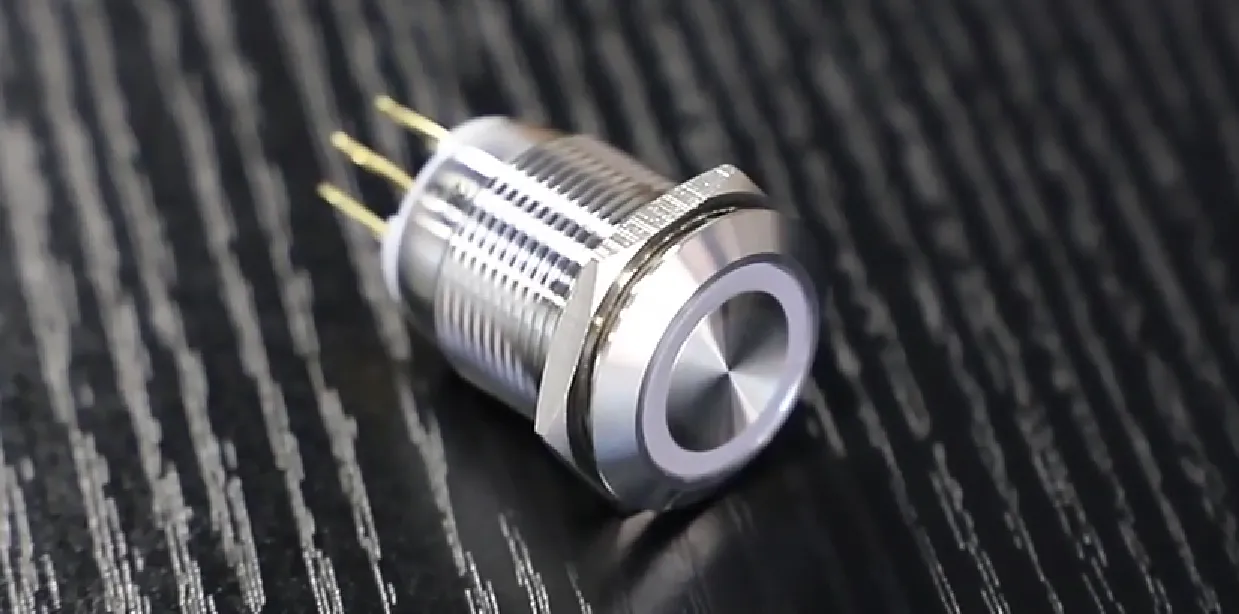
Ein Angebot für kundenspezifische kapazitive Schalter von Langir anfordern
Welche Anpassungsoptionen bietet Langir für das Design kapazitiver Schalter?
Wir bieten eine umfassende Palette von Anpassungsmöglichkeiten:
- Kundenspezifische Elektrodenformen und -größen, die genau in jeden Schalttafelausschnitt passen.
- Eine Auswahl an Abdeckmaterialien, darunter haltbares gehärtetes Glas und chemisch resistente Kunststoffe.
- Integration von Hintergrundbeleuchtung und Statusanzeige-LEDs.
- Optionen für IP67-Abdichtung, korrosionsbeständige Beschichtung und verbesserte mechanische Verstärkung.
Mit diesen umfangreichen Optionen können Sie eine Switch-Lösung maßschneidern, die auch die anspruchsvollsten industriellen Spezifikationen erfüllt.
Wie kann ich ein Angebot oder eine Beratung für Großbestellungen von kapazitiven Schaltern anfordern?
Um Ihre Projektanforderungen zu besprechen, einschließlich des Volumens, spezifischer technischer Details und des Projektzeitplans, wenden Sie sich bitte an unser Ingenieurteam. Besuchen Sie unsere Seite "Kontakt", um Ihre Anfrage zu starten und ein detailliertes Angebot zu erhalten.
Welche Zertifizierungen und Qualitätsstandards liegen den Industrieschaltern von Langir zugrunde?
Langir hat sich verpflichtet, die höchsten Branchenstandards einzuhalten:
- ISO 9001-Zertifizierung für umfassende Fertigungs- und Qualitätsmanagementsysteme.
- RoHS-Konformität, die die Kontrolle über die Verwendung gefährlicher Stoffe gewährleistet.
- UL-Bewertungen für die Einhaltung der elektrischen Sicherheit.
- Strenge interne AQL-Tests (Acceptable Quality Limit) für garantierte Zuverlässigkeit.
Diese Zeugnisse bieten eine dokumentierte Garantie für Leistung und Sicherheit für jeden Großauftrag, den wir ausführen.
Was sind die häufig gestellten Fragen zum Hinzufügen von Leitungen zu den kapazitiven Schaltern TTP223?
Hier finden Sie kurze Antworten auf häufig gestellte Fragen zur Erweiterung von TTP223-Modulen mit externen Elektroden.
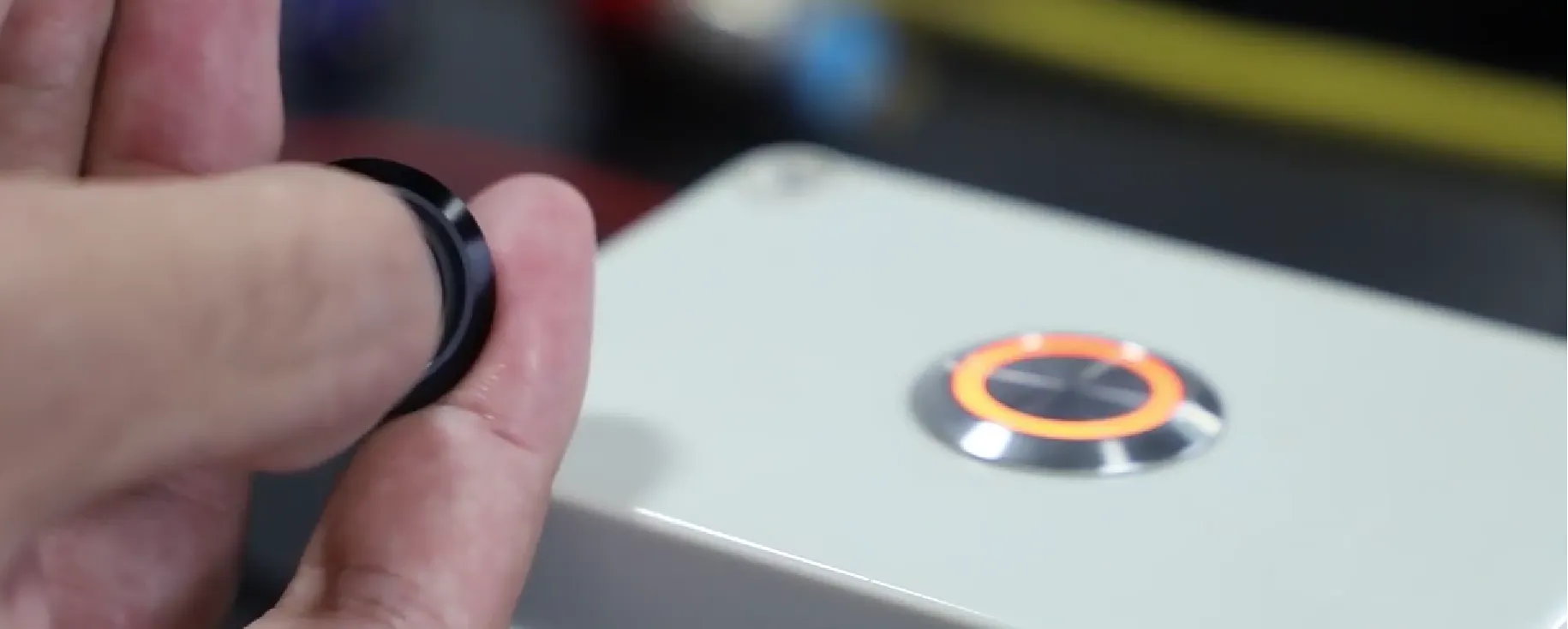
Ein Angebot für kundenspezifische kapazitive Schalter von Langir anfordern
Kann das Hinzufügen einer Leitung die Reaktionszeit oder Genauigkeit des Sensors beeinflussen?
Ja, die zusätzliche Kapazität, die durch verlängerte Kabel entsteht, kann die Reaktionszeit um 10-20 ms verlängern. Durch den Einsatz geeigneter Abstimmkondensatoren und abgeschirmter Kabel kann jedoch die ursprüngliche Geschwindigkeit und Präzision wiederhergestellt werden.
Was ist die maximal empfohlene Länge für eine externe Leitung?
Um einen stabilen Betrieb zu gewährleisten, ohne dass erweiterte Abschirmungstechniken erforderlich sind, ist es ratsam, die Länge der externen Kabel unter 150 mm zu halten. Bei größeren Längen verwenden Sie koaxiale oder foliengeschirmte Kabel in Verbindung mit einem 47 pF Abstimmkondensator.
Wie beeinflussen Umweltfaktoren die erweiterten kapazitiven Touchsensoren?
Erhebliche Temperaturschwankungen können die dielektrischen Eigenschaften von Materialien verändern, während Feuchtigkeitsansammlungen auf den Oberflächen zu fehlerhaften Messwerten führen können. Die Auswahl von Materialien mit geringer Feuchtigkeitsaufnahme und die Gewährleistung einer ordnungsgemäßen Abdichtung der Anschlüsse sind entscheidend für die Aufrechterhaltung einer gleichbleibenden Leistung.
Die Erweiterung eines kapazitiven TTP223-Schalters um ein externes Kabel eröffnet eine Welt vielseitiger Touch-Interface-Möglichkeiten für industrielle Steuerungsanwendungen, die ein robustes Design mit nahtloser Benutzerinteraktion verbinden. Durch die sorgfältige Auswahl von Materialien, die präzise Abstimmung der Empfindlichkeit und die Einhaltung von Best Practices bei der Erdung können Sie großflächige, versiegelte Touch-Tasten entwickeln, die herkömmliche mechanische Alternativen deutlich übertreffen. Wenn Sie bereit sind, kundenspezifische Lösungen zu erforschen oder eine fachkundige Anleitung zur Integration von kapazitiven Schaltern mit erweiterter Reichweite benötigen, laden wir Sie ein, sich noch heute mit dem Langir-Team in Verbindung zu setzen.
 DE
DE


 06/09/2025
06/09/2025